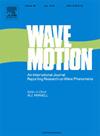一类具有局部旋转的各向异性弹性超材料的结构建模和波传播
IF 2.1
3区 物理与天体物理
Q2 ACOUSTICS
引用次数: 0
摘要
弹性超材料是典型的周期性材料,其单元格的工程结构远小于典型的现象长度尺度。开发能够准确表示上述结构效应的连续模型极具挑战性,因此这一领域的开发十分稀少。本文开发了一种新型二维连续模型,能够捕捉一类各向异性弹性超材料的动态行为,该超材料在长波长限制下具有局部旋转元素。本文提出了一种包含这些局部旋转效应的构成关系,并通过使用线性胡克弹簧和相同刚性盘的代表性离散模型进行了验证。新的连续模型用于生成沿任意方向传播的谐波平面波的频散关系,随后将其与原始离散模型的频散行为进行比较。然后分析了该连续体在各向异性介质中受到二维平面谐波传播时的一般行为,并特别关注了材料各向异性和波传播方向的影响。这项研究首次为一类具有局部旋转效应的各向异性弹性超材料建立了新的连续模型。本文章由计算机程序翻译,如有差异,请以英文原文为准。
Constitutive modelling and wave propagation through a class of anisotropic elastic metamaterials with local rotation
Elastic metamaterials are typically periodic materials possessing unit cells endowed with engineered architecture much smaller than the typical phenomenological length scale. The development of continuum models capable of accurately representing the effects of this aforementioned architecture is extremely challenging, and hence a sparsely developed area. This paper develops a novel 2-D continuum model capable of capturing the dynamic behaviour of a class of anisotropic elastic metamaterials with local rotational elements in the long wavelength limit. A constitutive relation incorporating these local rotational effects is proposed, and ratified using a representative discrete model using linear Hookean springs and identical rigid disks. The new continuum model is used to generate a dispersion relation for harmonic plane waves propagating in an arbitrary direction, which is subsequently compared to the dispersion behaviour of the original discrete model. The general behaviour of this continuum when subjected to 2-D planar harmonic wave propagation in the anisotropic medium is then analysed, with specific attention given to the effect of material anisotropy and wave propagation direction. This work is the first of its kind to create a new continuum model of a class of anisotropic elastic metamaterials with local rotational effects.
求助全文
通过发布文献求助,成功后即可免费获取论文全文。
去求助
来源期刊

Wave Motion
物理-力学
CiteScore
4.10
自引率
8.30%
发文量
118
审稿时长
3 months
期刊介绍:
Wave Motion is devoted to the cross fertilization of ideas, and to stimulating interaction between workers in various research areas in which wave propagation phenomena play a dominant role. The description and analysis of wave propagation phenomena provides a unifying thread connecting diverse areas of engineering and the physical sciences such as acoustics, optics, geophysics, seismology, electromagnetic theory, solid and fluid mechanics.
The journal publishes papers on analytical, numerical and experimental methods. Papers that address fundamentally new topics in wave phenomena or develop wave propagation methods for solving direct and inverse problems are of interest to the journal.
 求助内容:
求助内容: 应助结果提醒方式:
应助结果提醒方式:


